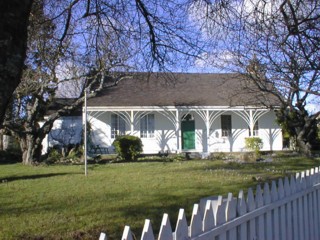2564 Heron Street


Tod House is a one-storey wooden house, built in three sections, situated on its original site at an angle to the present street. It is located in the Estevan or Willows neighbourhood of Oak Bay.
Tod House was the home of John Tod, Hudson’s Bay Company Factor and Chief Fur Trader at Kamloops, and one of the first appointed members of BC’s Legislative Council. Built by John Tod in 1850, this house is significant as an example of an early HBC farm settlement, and was the home of Oak Bay’s first retiree. This house represents the cross-cultural relationships of the HBC and First Nations people, as this was the home of Tod and his wife Sophia Lolo. This is one of the oldest houses in Victoria and notable as the longest continuously occupied residence in western Canada.
The house is a rare and intact example of the French Canadian style, piece-sur-piece construction, which was used extensively by Hudson’s Bay builders across Canada. Built in three sections, the transition from pioneer homestead to permanent residence is illustrated by the evolution of building technologies, from the 1850-52 log construction to the 1860’s frame construction addition.
Tod’s farm is important as one of five properties that comprise the first subdivision of HBC land in Oak Bay. Sold with the approval of Sir James Douglas on behalf of the HBC and surveyed by J. D. Pemberton, the devolution of HBC property followed the decline of the fur trade on Vancouver Island. The location of Tod House, in close proximity to the waterfront and its relationship to Cadboro(ugh) Bay Road via Tod Road, illustrates the important link between early urban development and the two historical transportation routes connecting the HBC farm with Fort Victoria.
- Angle of the house (in relationship to) the waterfront.
- Additive (3 section) single-storey form and small-scale rectangular massing.
- Squared-log structure of piece-sur-piece construction (1850-1852).
- Massive timber framing, dovetailed joints of early sections.
- Frame construction of the later addition (1860s).
- Clapboard exterior.
- Gabled bellcast roof.
- Original floor plan including low ceilings and door frames.
- Authentic (historic) interior detailing such as the hand hewn woodwork, fieldstone fireplaces in the kitchen and living room, (dating from the Tod family residence c.1850 - 1890).
- Mature cherry tree dating from the Tod family residence.
 Instagram
Instagram
 Facebook
Facebook
 Twitter
Follow @DistrictOakBay
Twitter
Follow @DistrictOakBay